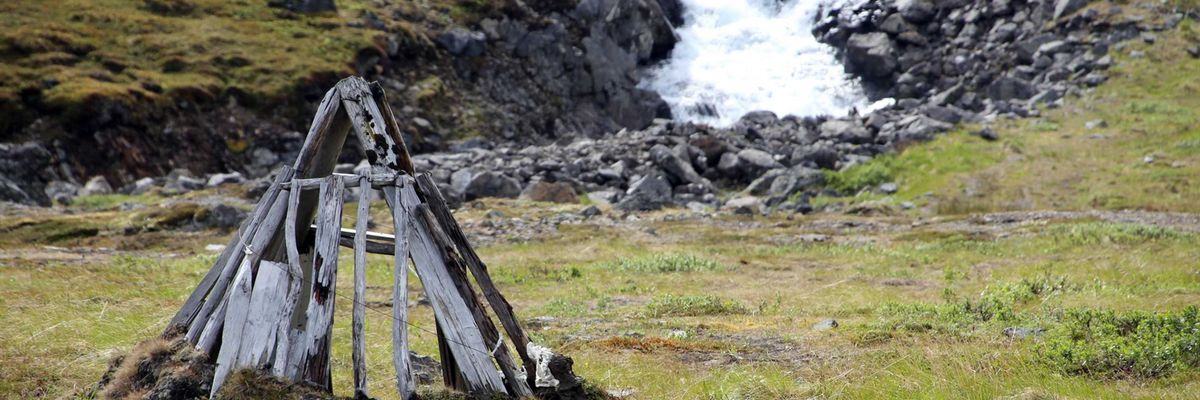environmentandaging
VIDEO: The facts on climate change -- and what to do about it.
In advance of Earth Day on April 22, National Geographic Magazine released its latest edition this week featuring the guide, “Seven Things You Need to Know about Climate Change.” It includes facts from scientists about the causes of climate change and how humans can help mitigate its consequences. For more, the magazine’s editor in chief Susan Goldberg joins Hari Sreenivasan.
The facts on climate change — and what to do about it
April 1, 2017 at 5:07 PM EDT
In advance of Earth Day on April 22, National Geographic Magazine released its latest edition this week featuring the guide, “Seven Things You Need to Know about Climate Change.” It includes facts from scientists about the causes of climate change and how humans can help mitigate its consequences. For more, the magazine’s editor in chief Susan Goldberg joins Hari Sreenivasan.
COMMENTS
MORE VIDEO
Can science make diagnosing PTSD less of an ordeal?What's stopping the vulnerable Everglades from being healed?Climate change is killing the Great Barrier Reef
LISTENSEE PODCASTS
HARI SREENIVASAN, PBS NEWSHOUR WEEKEND ANCHOR: 2014 was the hottest year on Earth since modern record-keeping began in 1880. That is, until 2015. And then that was replaced by the hottest year on record, 2016.
In advance of Earth Day, which occurs three weeks from today, on Saturday, April 22nd, the new edition of “National Geographic” magazine out this week, and the website, www.natgeo.com, have published “Seven Things You Need to Know About Climate Change.”
To discuss that guide and related issues, I’m joined from Washington by “National Geographic” editor-in-chief Susan Goldberg.
First, why does “National Geographic” feel it’s necessary to do this type of a story?
SUSAN GOLDBERG, EDITOR IN CHIEF, NATIONAL GEOGRAPHIC: We want to do stories about climate change because “National Geographic” has been doing this kind of coverage for our — really, the entirety of our 129-year history. We’ve been writing about the planet and the health of the planet, animals, the environment, history, and cultures. And all of these topics are affected by what we’re seeing with climate change
SREENIVASAN: You’re not a partisan organization. You’re not trying to take sides in the political debate, though, are you strongly pro-science and pro-fact.
GOLDBERG: Well, what we always say is we’re on the side of science, we’re on the side of the facts, and we’re on the side of the planet. And I think you can be on the side of the planet and not be partisan. We are a proudly and strongly nonpartisan organization, but what we are trying to do is give policymakers and the public the facts so they can make informed decisions about things like climate change, the Environmental Protection Agency, and how to keep the planet healthy
SREENIVASAN: All right. Let’s take a look at the cover the piece. It rattles off some of these seven reasons that the world is warming, number two, it’s because of us, and three, we’re sure. Those are usually the topics that are the most challenged by climate-change skeptics or deniers?
GOLDBERG: People almost view how they view climate change as part of their identity. The way I think we can play a role here is to help people understand by presenting stories through pictures, through amazing graphics, and, also, dishing up a healthy dose of the facts, but doing so in a way that will draw people in, rather than put them off
SREENIVASAN: One of the sections in your magazine is the ice is melting fast. We have heard several different stories just in the last few months about ice shelves breaking off. How significant is this?
GOLDBERG: Well, it’s really significant in two ways. If you took Alaska and California’s land mass together, that’s how much sea ice didn’t form this year in the Arctic. And then what– and so, that’s one aspect of the story. The other is the melting of the ice sheets and glaciers in Greenland and in the Antarctic and the melting of those is what’s causing the sea level rise that we’re already starting to see.
SREENIVASAN: We’re also seeing wildlife being impacted around the world. I mean, there were stories just in the last few weeks about huge chunks of the Great Barrier Reef that are dead.
GOLDBERG: Exactly. And the coral is just one aspect of what’s happening with the rise of sea temperatures and the rising acidification of the seas. So, we’re seeing animals showing up in place where’s they never really have before, whether you’re talking about what happens underneath the water or on the land
SREENIVASAN: You know, and this is at a time when you have new leadership at the White House and also the Environmental Protection Agency, and they’re making fairly significant policy judgments right now.
GOLDBERG: The administration has proposed a 31 percent cutback in the EPA, and while, this of course, has to go through Congress, and it could look different on the end, the president’s budget is always a good indication of his agenda. So, he wants to cut back the EPA 31 percent, dismantle programs to clean up the Great Lakes, clean up Chesapeake Bay, clean up Puget Sound and any number of other areas.
So, it’s our job at “National Geographic,” not to comment on the policy change, but to explain how that could affect people and wildlife
SREENIVASAN: Susan Goldberg, editor in chief of “National Geographic” — joining us from Washington today. Thanks so much.
GOLDBERG: Thank you, Hari. Appreciate it.
Is climate change putting elderly Londoners at risk?
A new study highlights Hackney, Islington and Tower Hamlets as having populations with highest health risk from rising temperatures.
8/18/2016 Is climate change putting elderly Londoners at risk?
https://www.businessgreen.com/bg/analysis/2468226/is-climate-change-is-putting-elderly-londoners-at-risk 1/4
Is climate change putting elderly
Londoners atrisk?
Arup study highlights Hackney, Islington and Tower Hamlets as having populations with highest
health risk from rising temperatures
London is currently on track for one of its warmest summers on record, and, with temperatures
expected to soar more frequently over the coming decades, there are perhaps some heat-seekers
secretly welcoming climate change with open arms, outstretched out on their sunbeds.
Yet, aside from the great many dangers climate change presents for the environment and
resources, the rising heat also poses a significant health risk to the most vulnerable in society -
8/18/2016 Is climate change putting elderly Londoners at risk?
https://www.businessgreen.com/bg/analysis/2468226/is-climate-change-is-putting-elderly-londoners-at-risk 2/4
particularly in cities.
Estimates suggest the number of people living in urban areas around the world is continuing to grow
alongside a rapidly ageing global population. People aged 65 and older are expected to make up 22
per cent of the total world population by 2050, while the number aged 80 or older is set to quadruple
over the same period.
According to a new study led by global engineering and consulting firm Arup, these combined trends
mean more and more people will be exposed and vulnerable to climate change impacts in cities in
the future.
The study - Seasonal Health and Resilience for Ageing Populations and Urban Environments
(dubbed 'SHARPER' for short) - suggests hotter temperatures are already putting elderly residents in
London at increasing risk of heat-related illnesses, with those most at risk likely to be in the central
boroughs of Hackney, Islington, and Tower Hamlets.
Work must therefore now focus on raising awareness and reducing the impact of the increasing
numbers of heatwaves expected in the capital, it argues.
Heatwaves are identified as prolonged periods of excessively hot weather where the temperature
exceeds the average maximum temperature by 5C for five consecutive days. The last time such an
event took place in London was in summer 2013, while other heatwaves have also recently hit the
capital in 2003, 2006 and 2011.
However, major heatwaves are expected to increase from occurring once every two decades to as
frequently as once every three years by 2050 due to the changing global climate, according to the
study.
In addition, the study used satellite data to obtain surface temperature maps for the capital, which
revealed temperature differences of as much as 10C between different areas during the 2003
heatwave.
According to Arup, these variances are explained by a phenomenon known as the 'Urban Heat Island
Effect', which occurs when heat is absorbed and released by buildings and paved surfaces, resulting in
a warmer microclimate. In short, it means dense, built-up areas in cities with a lack of trees and green
spaces are impacted most by the phenomenon, and populations in these areas often experience the
highest temperatures during heatwaves.
8/18/2016 Is climate change putting elderly Londoners at risk?
https://www.businessgreen.com/bg/analysis/2468226/is-climate-change-is-putting-elderly-londoners-at-risk 3/4
At the same time, over 65s are particularly susceptible to heat stroke and exhaustion, while
heatwaves can also exacerbate impairments associated with pre-existing health conditions such as
asthma, heart disease and diabetes.
The obvious conclusion from these various findings is clear - older people in densely populated urban
areas are those at the greatest health risk during periods of hot temperatures, which are set to
become ever more frequent due to climate change.
Food for thought, perhaps, for climate sceptics such as Donald Trump - a 70-year-old with scores of
high-density residences in major cities.
"The combination of climate change, rapid urbanisation and ageing populations is increasing the
impact of extreme weather events, such as heat waves, experienced by global cities like London," said
Polly Tuton, environmental consultant at Arup. "We all - planners, urban designers, engineers,
property developers and politicians - have an opportunity to help vulnerable members of our
communities cope with increasing heat waves."
Heat Vulnerability Index
In order to raise awareness of the issue and identify priority areas for mitigation measures, Arup has
also developed a new Heat Vulnerability Index (HVI) as part of the study, which was also supported by
HelpAge International, the Satellite Applications Catapult, Climate UK, King's College London,
University College London, and the Natural Environment Research Council (NERC).
Based on a combination of satellite heat data and socio-economic factors such as population density,
health, mobility and quality of housing, the Index reiterates that Hackney, Islington and Tower
Hamlets are the areas of London where the population is most at risk from hot temperatures.
The Index takes account of the Urban Heat Island Effect, but also the cooling effect of medium and
large scale green spaces, agricultural land and water bodies during the day.
Such areas represent 31 per cent of London's overall surface area, which, for example, compares to 26
per cent of the surface area in New York City, where built up areas therefore make up the remaining 74
per cent of the total.
However, the percentage of 'land cover' can vary considerably between areas, and Hackney, Islington
and Tower Hamlets have some of the highest proportions of built-up areas in London, contributing to
8/18/2016 Is climate change putting elderly Londoners at risk?
https://www.businessgreen.com/bg/analysis/2468226/is-climate-change-is-putting-elderly-londoners-at-risk 4/4
© Incisive Business Media (IP) Limited, Published by Incisive Business Media
Limited, Haymarket House, 28-29 Haymarket, London SW1Y 4RX, are companies
registered in England and Wales with company registration numbers 9177174 &
9178013
Digital publisher of the
year 2010, 2013 & 2016
a greater intensity of heat in these areas.
1 2









